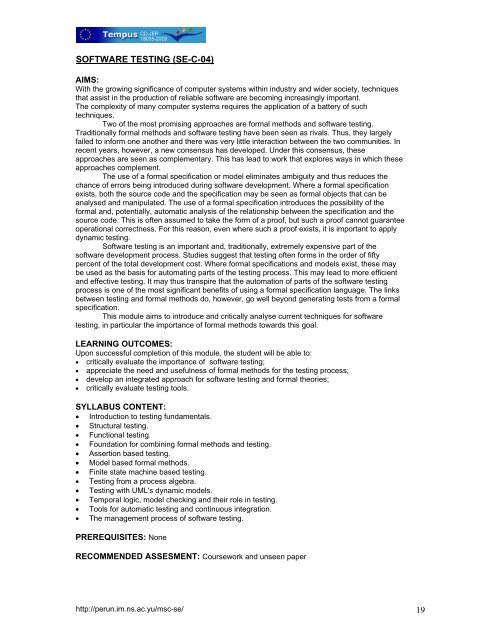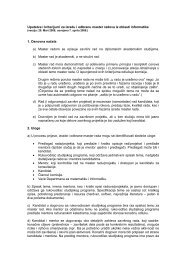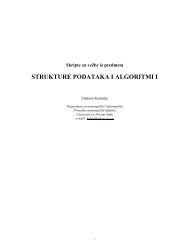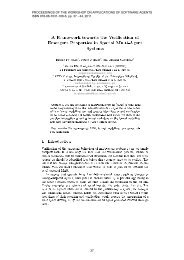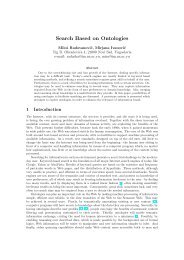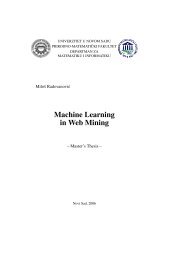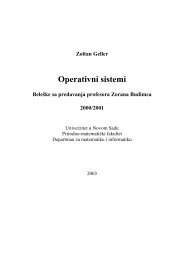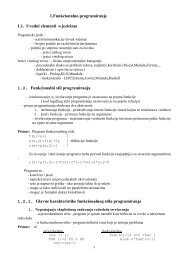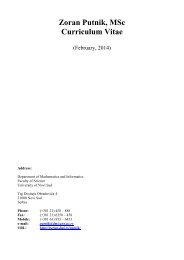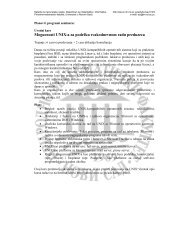Full document describing all aspects of the curriculum, release 2 (pdf)
Full document describing all aspects of the curriculum, release 2 (pdf)
Full document describing all aspects of the curriculum, release 2 (pdf)
Create successful ePaper yourself
Turn your PDF publications into a flip-book with our unique Google optimized e-Paper software.
SOFTWARE TESTING (SE-C-04)AIMS:With <strong>the</strong> growing significance <strong>of</strong> computer systems within industry and wider society, techniquesthat assist in <strong>the</strong> production <strong>of</strong> reliable s<strong>of</strong>tware are becoming increasingly important.The complexity <strong>of</strong> many computer systems requires <strong>the</strong> application <strong>of</strong> a battery <strong>of</strong> suchtechniques.Two <strong>of</strong> <strong>the</strong> most promising approaches are formal methods and s<strong>of</strong>tware testing.Tradition<strong>all</strong>y formal methods and s<strong>of</strong>tware testing have been seen as rivals. Thus, <strong>the</strong>y largelyfailed to inform one ano<strong>the</strong>r and <strong>the</strong>re was very little interaction between <strong>the</strong> two communities. Inrecent years, however, a new consensus has developed. Under this consensus, <strong>the</strong>seapproaches are seen as complementary. This has lead to work that explores ways in which <strong>the</strong>seapproaches complement.The use <strong>of</strong> a formal specification or model eliminates ambiguity and thus reduces <strong>the</strong>chance <strong>of</strong> errors being introduced during s<strong>of</strong>tware development. Where a formal specificationexists, both <strong>the</strong> source code and <strong>the</strong> specification may be seen as formal objects that can beanalysed and manipulated. The use <strong>of</strong> a formal specification introduces <strong>the</strong> possibility <strong>of</strong> <strong>the</strong>formal and, potenti<strong>all</strong>y, automatic analysis <strong>of</strong> <strong>the</strong> relationship between <strong>the</strong> specification and <strong>the</strong>source code. This is <strong>of</strong>ten assumed to take <strong>the</strong> form <strong>of</strong> a pro<strong>of</strong>, but such a pro<strong>of</strong> cannot guaranteeoperational correctness. For this reason, even where such a pro<strong>of</strong> exists, it is important to applydynamic testing.S<strong>of</strong>tware testing is an important and, tradition<strong>all</strong>y, extremely expensive part <strong>of</strong> <strong>the</strong>s<strong>of</strong>tware development process. Studies suggest that testing <strong>of</strong>ten forms in <strong>the</strong> order <strong>of</strong> fiftypercent <strong>of</strong> <strong>the</strong> total development cost. Where formal specifications and models exist, <strong>the</strong>se maybe used as <strong>the</strong> basis for automating parts <strong>of</strong> <strong>the</strong> testing process. This may lead to more efficientand effective testing. It may thus transpire that <strong>the</strong> automation <strong>of</strong> parts <strong>of</strong> <strong>the</strong> s<strong>of</strong>tware testingprocess is one <strong>of</strong> <strong>the</strong> most significant benefits <strong>of</strong> using a formal specification language. The linksbetween testing and formal methods do, however, go well beyond generating tests from a formalspecification.This module aims to introduce and critic<strong>all</strong>y analyse current techniques for s<strong>of</strong>twaretesting, in particular <strong>the</strong> importance <strong>of</strong> formal methods towards this goal.LEARNING OUTCOMES:Upon successful completion <strong>of</strong> this module, <strong>the</strong> student will be able to:• critic<strong>all</strong>y evaluate <strong>the</strong> importance <strong>of</strong> s<strong>of</strong>tware testing;• appreciate <strong>the</strong> need and usefulness <strong>of</strong> formal methods for <strong>the</strong> testing process;• develop an integrated approach for s<strong>of</strong>tware testing and formal <strong>the</strong>ories;• critic<strong>all</strong>y evaluate testing tools.SYLLABUS CONTENT:• Introduction to testing fundamentals.• Structural testing.• Functional testing.• Foundation for combining formal methods and testing.• Assertion based testing.• Model based formal methods.• Finite state machine based testing.• Testing from a process algebra.• Testing with UML's dynamic models.• Temporal logic, model checking and <strong>the</strong>ir role in testing.• Tools for automatic testing and continuous integration.• The management process <strong>of</strong> s<strong>of</strong>tware testing.PREREQUISITES: NoneRECOMMENDED ASSESMENT: Coursework and unseen paperhttp://perun.im.ns.ac.yu/msc-se/ 19


